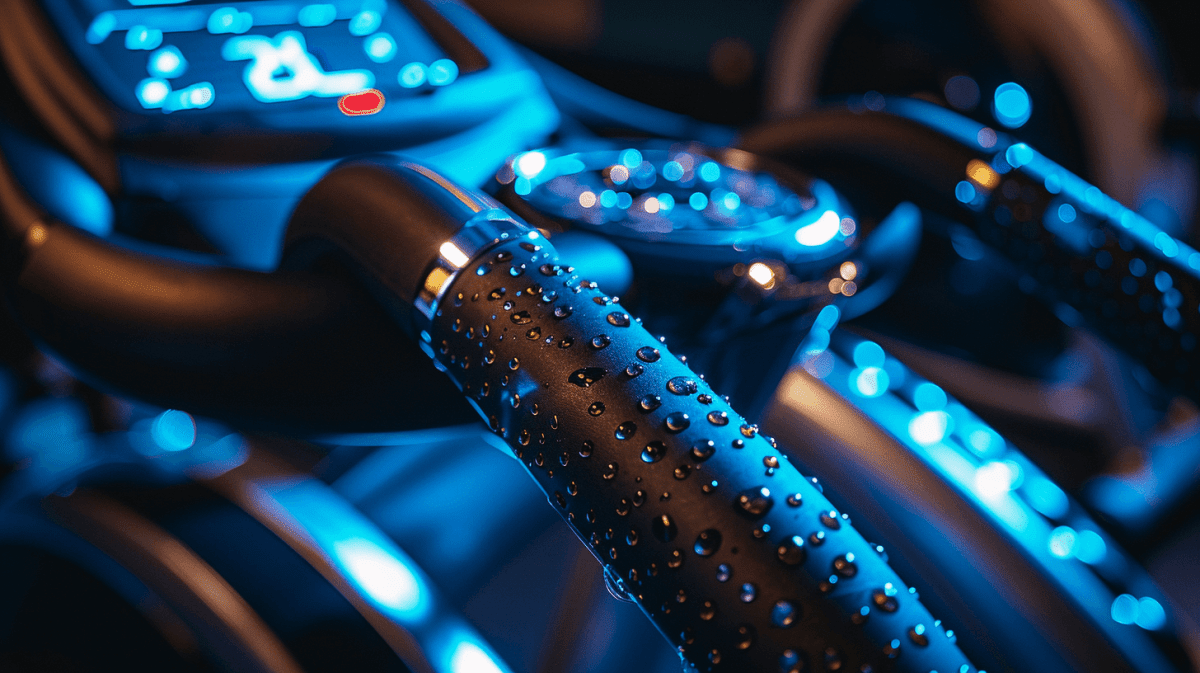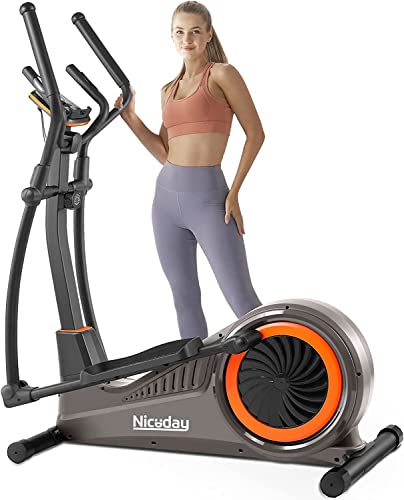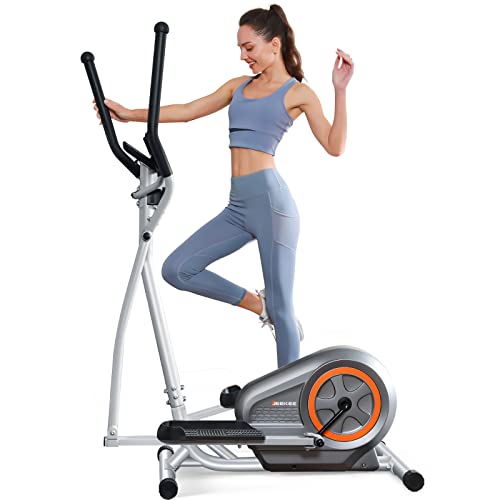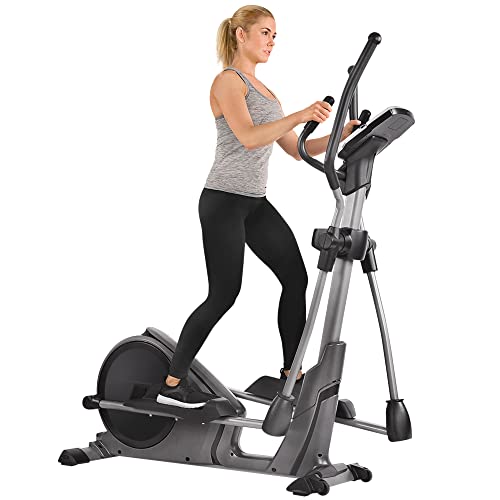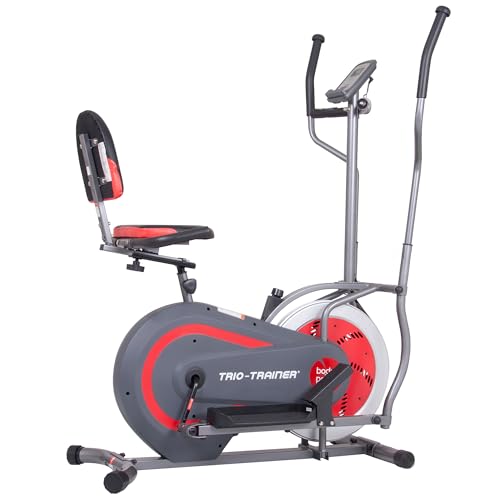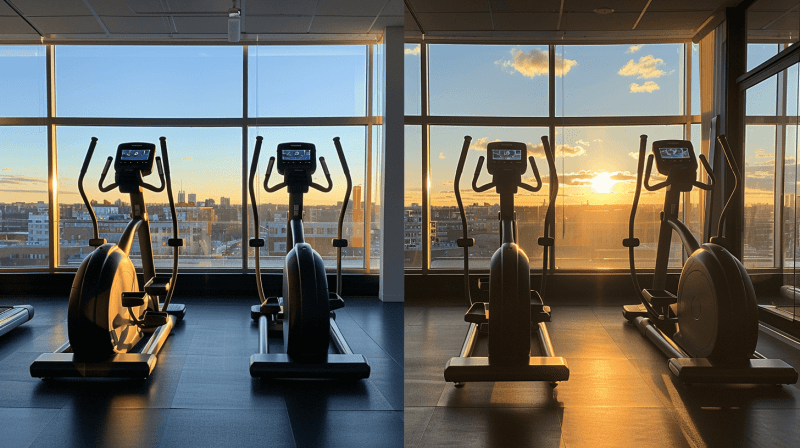When you're tracking your fitness goals on an elliptical machine, you'll want to know exactly how far you've traveled. While most modern ellipticals display your distance digitally, understanding the actual number of rotations needed for a mile can help you verify your progress and maintain accuracy across different machines. The relationship between stride length and rotations isn't always straightforward, and many exercisers are surprised to learn that the standard 20-inch stride requires over 1,500 rotations to complete a mile. Let's explore how these calculations work and why they matter for your workout routine.
Key Takeaways
-
The number of rotations per mile depends on the stride length of the elliptical machine, typically ranging from 14 to 22 inches.
-
For a standard 20-inch stride length elliptical, it takes 1,584 rotations to complete one mile.
-
Calculate rotations per mile by dividing 63,360 (inches per mile) by stride length, then dividing that number by 2.
-
Shorter stride lengths require more rotations per mile, while longer stride lengths need fewer rotations to cover the distance.
-
Each full rotation equals two strides, so a mile at 20-inch stride length requires 3,168 strides or 1,584 rotations.
Understanding SPM and RPM Basics
When working out on an elliptical machine, you'll need to understand two key measurements: SPM (Strides Per Minute) and RPM (Revolutions Per Minute). These measurements help you track your progress and accurately calculate the distance you've covered during your workout session.
SPM refers to the number of times one foot completes a half revolution in a minute, while RPM counts the number of complete revolutions both feet make in the same timeframe. To put this in perspective, when you're moving at 120 SPM, you're actually completing 60 RPM, as each full revolution requires two strides.
The relationship between these measurements becomes particularly important when you're trying to determine how far you've traveled. Your elliptical's stride length plays an indispensable role in this calculation. For instance, if you're using a machine with a 20-inch stride length, you'll need to complete 3,168 strides to reach one mile. To convert this to RPM, you'll simply divide this number by two, giving you the exact number of revolutions required to travel a mile on your specific machine. Maintaining proper pedaling speed throughout your workout ensures optimal muscle engagement while preventing fatigue from excessive rotation rates.
Measuring Your Elliptical Stride Length
Before you can determine the number of rotations needed for a mile, measuring your elliptical's stride length is vital. Most elliptical machines have stride lengths ranging from 14 to 22 inches, and knowing your specific machine's measurement will help you accurately track your workout progress and distance covered.
If you're not sure about your elliptical's stride length, you'll want to consult your machine's manual or contact the manufacturer directly. The stride length measurement is indispensable because it's the foundation for calculating both your strides and rotations per mile. For instance, if you're working with a 20-inch stride length, you'll complete 3,168 strides to cover one mile.
Understanding your stride length also helps you calculate your rotations more precisely. Since each rotation on an elliptical consists of two strides, you'll need to divide your total strides per mile by two. Using the previous example with a 20-inch stride length, you'd perform 1,584 rotations to complete one mile. This knowledge guarantees you're tracking your distance accurately and meeting your fitness goals with precision. Premium models like the NordicTrack Commercial 14.9 offer adjustable stride lengths from 17.5 to 18.7 inches to accommodate different user heights and preferences.
The Mile Calculation Formula
A simple formula exists for calculating rotations needed to cover a mile on your elliptical machine. To determine this number, you'll need to divide 63,360 (the total inches in a mile) by your machine's stride length in inches. This calculation will give you the total number of strides required for a complete mile.
Since each rotation on the elliptical consists of two steps (one with each foot), you'll need to divide your total strides by two to find the actual rotations per minute (RPM) needed. For instance, if you're using an elliptical with a 20-inch stride length, you'll first calculate 63,360 divided by 20, which equals 3,168 strides. Then, divide this number by two to get 1,584 rotations needed to complete one mile.
Understanding this formula helps you track your workout progress more accurately. You can adjust your elliptical's stride length to modify the required rotations, which allows you to customize your workout intensity and target different muscle groups. This knowledge enables you to set more precise fitness goals and monitor your distance coverage effectively. For optimal results, maintaining proper elliptical technique with an engaged core and straight posture will help ensure accurate distance tracking.
Stride Length Impact on Distance
Stride length plays a pivotal role in determining how many rotations you'll need to complete a mile on your elliptical machine. When you're using an elliptical with a shorter stride length, you'll need to complete more rotations to cover the same distance compared to a machine with a longer stride setting.
To put this into perspective, consider an elliptical with a 20-inch stride length, which requires approximately 1,584 rotations to complete a mile. This calculation comes from dividing the total inches in a mile (63,360) by the stride length and accounting for the two steps that make up each rotation.
If you're using an adjustable stride length machine, you'll find that selecting a longer stride setting reduces the number of rotations needed per mile, while a shorter stride increases them.
Comprehending how stride lengths affect your distance tracking is essential for maintaining accurate workout measurements. When you're using different elliptical machines or adjusting your stride settings, you'll need to account for these variations to guarantee you're correctly tracking your exercise progress and meeting your fitness goals. Maintaining proper foot alignment while tracking your distance helps ensure optimal body mechanics and reduces the risk of injury during your workout.
Converting Steps to Miles
Converting your elliptical steps to miles requires understanding the relationship between strides and rotations. When you're tracking the distance traveled on an elliptical, it's crucial to know that every mile consists of 1,584 complete revolutions on a machine with a 20-inch stride length. This relationship helps you accurately measure your workout progress.
To make your distance calculations more practical, you can use time as a reliable measure. The number of steps you take during your elliptical workout can be estimated by multiplying your workout duration in minutes by 203, giving you a walking-equivalent step count.
- Monitor your revolutions per minute to maintain a consistent pace throughout your workout
- Track the length of your elliptical stride to guarantee accurate distance measurements
- Record your total workout time to calculate equivalent walking steps
- Keep a log of your progress to stay motivated and reach your fitness goals
Understanding these conversions helps you accurately track your fitness journey, whether you're focusing on distance covered or step count equivalents. The key is maintaining consistency in your measurements while considering your machine's specific stride length specifications. For optimal results, incorporate interval training techniques by alternating between moderate and recovery periods during your workout.
Tracking Accurate Distance Metrics
Distance tracking accuracy relies heavily on understanding your elliptical's specific measurements and settings. Since many elliptical machines don't provide precise distance measurements, you'll need to calculate rotations manually using your machine's stride length to track your progress effectively.
To guarantee accurate distance monitoring on your elliptical trainer, start by identifying the stride length, typically measured in inches. You can calculate your total rotations per mile by dividing 63,360 (total inches in a mile) by your stride length, then dividing that result by two. For example, if you're using an elliptical machine with a 20-inch stride length, you'll need 1,584 rotations to complete one mile.
Keep in mind that some elliptical models feature adjustable foot pads that can modify the stride length. When you adjust these settings, you'll need to recalculate your rotations per mile accordingly. By maintaining accurate records of your stride length and corresponding rotations, you can track your distance more precisely than relying solely on the machine's built-in measurements, confirming more reliable progress monitoring during your workouts. Utilizing interval training techniques during your elliptical workouts can help you maximize calorie burn while accurately tracking your distance goals.
Adjusting for Different Machines
When switching between different elliptical machines, you'll need to adapt your rotation calculations to match each specific model. The Editorial Process of tracking your distance accurately requires understanding that stride length variations greatly impact the number of rotations needed to complete a mile.
For machines with adjustable stride lengths, you'll need to recalculate your rotations whenever you modify the settings. This customization capability offers workout flexibility but requires vigilant monitoring to maintain accurate distance measurements.
- Check the manufacturer's specifications for the exact stride length of your machine
- Measure the stride length manually if specifications aren't available
- Document the rotation counts for different stride length settings
- Update your tracking method when switching between machines
Comprehending stride length differences is vital for maintaining consistent distance measurements across various elliptical models. A longer stride length means you'll need fewer rotations to cover a mile, while shorter strides require more rotations to achieve the same distance. By adjusting your calculations based on each machine's specific measurements, you'll guarantee your distance tracking remains precise and reliable for monitoring your fitness progress.
Optimizing Your Elliptical Workout
Several key strategies can maximize the effectiveness of your elliptical workout beyond just counting rotations. Start by establishing a moderate pace that you can maintain consistently throughout your session, then gradually increase resistance levels as your endurance improves. You'll want to maintain proper form by keeping your core engaged and your shoulders back while gripping the handles lightly.
To optimize calorie burn and muscle engagement, incorporate interval training into your routine. Alternate between periods of higher intensity and recovery phases, adjusting both speed and resistance to challenge different muscle groups. You can also vary your stride length and direction to target different muscle groups more effectively.
Don't forget to monitor your heart rate to guarantee you're working within your target zone. Most ellipticals feature built-in heart rate monitors, which you can use to adjust your effort level accordingly. While focusing on these elements, remember to stay hydrated and maintain steady breathing throughout your workout.
For best results, aim to include both forward and backward pedaling motions, and consider using the preset programs on your machine to add variety to your routine.
Common Measurement Mistakes
Many users run into trouble when trying to track their distance on elliptical machines. The displayed measurements often provide inaccurate data, leading to confusion about actual workout progress. Through our Editorial Process, we've found that relying solely on the machine's distance calculations can greatly impact your fitness tracking goals.
Understanding common measurement pitfalls can help you avoid these tracking errors:
- Assuming the machine's displayed distance is accurate, which can lead to unrealistic expectations about your workout achievements
- Not accounting for personal stride length differences, resulting in skewed distance calculations
- Overlooking the impact of stride adjustments on distance measurements
- Failing to cross-reference machine data with manual calculations based on stride length
To get more accurate measurements, you'll need to examine your specific machine's stride length and make appropriate adjustments. The relationship between rotations and actual distance varies significantly between different elliptical models and users. When tracking your progress, it's crucial to maintain consistency in your measurement method rather than relying exclusively on the machine's displayed metrics.
Digital Distance Tracking Tools
Today's elliptical machines leverage advanced digital tracking tools to enhance workout precision and monitoring. These modern devices come equipped with built-in sensors that accurately measure your rotations and automatically convert them into distance measurements, making it easier than ever to track your progress during workouts.
The integration of digital tracking capabilities has revolutionized how you can monitor your elliptical exercises. Many machines now sync seamlessly with popular fitness apps and wearable devices, allowing you to log your distance, duration, and other important metrics automatically. As part of our Editorial Process, we've found that these digital tools provide real-time feedback on your performance, helping you maintain proper pace and intensity throughout your workout.
For ideal distance tracking, you'll find dedicated apps specifically designed to work with elliptical machines. These applications not only record your mileage but also store your workout history, enabling you to analyze your progress over time. Whether you're using the machine's built-in tracking system or a third-party app, digital tools have made it more convenient to measure and achieve your fitness goals with precision.
Frequently Asked Questions
How Many Revolutions on Elliptical Equal Mile?
When you're tracking your consistent elliptical usage, it takes 1,584 revolutions to equal one mile on a standard 20-inch stride machine. You'll need more revolutions if your elliptical has a shorter stride length.
What Is 1 Mile on an Elliptical?
With a standard 20-inch stride length, you'll complete 1,584 rotations to reach one mile on your elliptical. This equivalence guarantees you're accurately tracking your distance during workouts for optimal performance monitoring.
How Many Rotations on an Elliptical Is a Mile?
You'll need to check your elliptical's stride length estimation to calculate rotations per mile. With a typical 18-inch stride, you'd need around 3,500 rotations, but this varies by machine model.
How Long on an Elliptical to Get 10,000 Steps?
You'll need about 50 minutes on the elliptical to reach 10,000 steps. Keep your pacing consistency steady at around 200 steps per minute, and you'll hit your goal with regular movement.
Conclusion
While you might worry that counting rotations will distract from your workout, understanding that 1,584 rotations equals one mile at a 20-inch stride length gives you a reliable fitness benchmark. You'll find that this knowledge helps you track progress more accurately, even when your machine's digital display isn't working properly. Remember to adjust these calculations based on your specific machine's stride length for the most accurate distance tracking.
